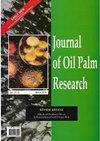PALM KERNEL MEAL ACTIVATED CARBON VIA GLASS WOOL-PYROLYSIS METHOD FOR CEFTRIAXONE ADSORPTION
IF 1.3
4区 农林科学
Q2 Agricultural and Biological Sciences
引用次数: 0
Abstract
Antibiotic residues are a primary environmental concern because they are difficult to remove, including in wastewater treatment plants. A one-pot glass wool-pyrolysis method was developed and utilised to convert palm kernel meal into activated carbon from palm kernel meal (AC-PKM) over process temperatures 750°C for 5 hr as an adsorbent for antibiotic residues. Physicochemical properties, semi-quantitative specific surface area, surface functional group profiles, and scanning electron microscopy (SEM) were evaluated. The physicochemical properties of AC-PKM meet the standards set by SNI 06-3730-1995 with a semi-quantitative specific surface area of 751 m 2 /g. Fourier transform infrared (FTIR) analysis shows that the active functional groups are scattered on the surface of AC-PKM. The maximum adsorption capacity is 82.64 mg/g adsorbent and can be explained by the Langmuir isotherm and pseudo-second-order type I kinetic model. The thermodynamic investigation showed that the adsorption process is a spontaneous endothermic reaction. The AC-PKM can remove 26% ceftriaxone (as a model residue antibiotic) for 2 hr of contact at a neutral pH at room temperature. The results show great promise of the one-pot glass wool-pyrolysis method to produce desirable activated carbon for removing ceftriaxone (CFT) application and an alternative treatment for the reuse of palm kernel meal waste.棕榈仁粕活性炭采用玻璃毛热解法对头孢曲松进行吸附
本文章由计算机程序翻译,如有差异,请以英文原文为准。
求助全文
约1分钟内获得全文
求助全文
来源期刊

Journal of Oil Palm Research
农林科学-食品科技
CiteScore
2.60
自引率
30.80%
发文量
69
审稿时长
>12 weeks
期刊介绍:
JOURNAL OF OIL PALM RESEARCH, an international refereed journal, carries full-length original research papers and scientific review papers on various aspects of oil palm and palm oil and other palms. It also publishes short communications, letters to editor and reviews of relevant books. JOURNAL OF OIL PALM RESEARCH is published four times per year, i.e. March, June, September and December.
 求助内容:
求助内容: 应助结果提醒方式:
应助结果提醒方式:


